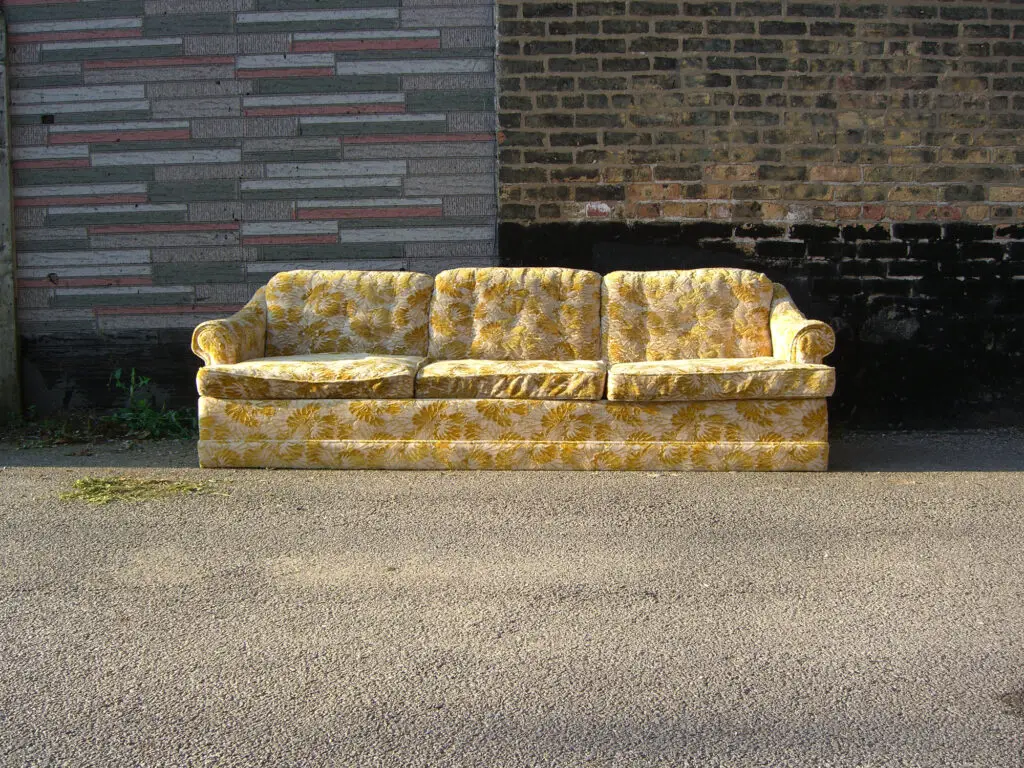The expected lifespan of a couch is eight to 10 years. Abuse, poor maintenance, and changing demands can speed up the need to replace a couch. With proper upkeep and an investment in quality, a couch can last much longer than 10 years before needing a replacement.
Do you know when to replace a couch?
Sometimes, we don’t have to wait for our couch to fall apart when we sit down to know we need a replacement sofa. Several factors can determine when to replace a sofa. Even it’s still in relatively good conditions, it may not have the same value it used to, whether you realize it or not.
If you have been wondering when it’s a good time to update your couch, we’ll show you exactly how to tell if you’re getting the most out of it.
Table of Contents
How to Know When to Replace a Couch
The average lifespan of a sofa is about eight to 10 years. This can be expected for everyday use and normal wear and tear. With proper upkeep, you can potentially double its life.
As a guide for when to replace a couch, the expected lifespan means nothing. Instead, you should focus on the fit, fashion, and function in your room to see if it ticks off essential criteria.
The Condition
Is your leather starting to crack? Do tiny flecks of your faux leather couch hang onto your pants whenever you stand up? Are you seeing rips or frays opening up in your fabric?
If your upholstery or leather is frayed, torn, irreparably stained, or otherwise beat up, it’s time to replace the couch. Reupholstering a couch may sound like a good alternative, but it can sometimes cost more than buying a brand new one. Unless the sofa has deep sentimental value, you should upgrade to a new one with fresh fabric, frames, and features.
You have some control over how long your fabric and leather lasts, so it’s crucial to research proper care for the exact material you have. The pandemic has kept many of us at home, so if your furniture has seen more use, you might want to give it a refresh to improve the look and extend its life.
In general, you want to limit sunlight exposure with any indoor couch material to retain its color and keep it safe from the heat. Condition leather to keep it from drying out, and pay special attention to cleaning codes for the fabric to ensure you don’t damage it with harmful solvents.
The Comfort
If your couch sinks in a little too far when you sit down, you need a new couch. You might notice that it’s hard to get in or out of the couch because it sags. You may even suffer from lingering aches and pains, especially in the back, neck, and shoulders, from lack of support.
A couch can break down in several ways, including the following:
- Compressed couch cushion foam cores
- Sagging under-cushion support
- Warped or broken frame
There are solutions for failing components that can revitalize your couch’s comfort. For example, you can cut a plywood platform to make up for sagging springs, but solutions like this should be temporary at best. If you need to resort to these measures, it should just be to get you by until you get a new sofa delivered.
You can get more life out of your sofa through smart shopping. Research the construction and cushion style of your couch options to find the most resilient design.
The Sound and Smell
If you hear creaking, squeaking, or crunching, it’s often a sign that your springs or frame are starting to fail. It’s only a matter of time before something breaks. Replacing the couch should be a priority if this starts to accompany comfort issues because it may injure someone when it finally gives out.
When you have pets or if your sofa has seen its fair share of spills, it will usually pick up odors to match the stains. Leather and faux leather options are less of a concern because the covers don’t absorb odors, making them great materials for pet owners. Still, spills and liquids can seep between seams to affect foam cores and batting, which will gladly soak up anything that comes their way.
Liquid reaching foam cores can be an issue. When they’re allowed to sit or continually happen, spills can soak deep into cushions, making them smell terrible and potentially wearing down the foam’s strength.
If you have fabric, you can try to steam clean your upholstery if you have surface-level stains. Be wary of the material though, as some fabrics will break or wear easily from abrasive cleaners.
The Size
The size of your couch may need to change if you move it to another room. An oversized sofa can obstruct door swings and walking paths while a small couch might look out of place.
A move to a new room isn’t the only way a couch’s size can cause problems.
Maybe the kids are getting bigger, and they need more space on the family sofa. Or you might have gotten a new three-piece cocktail table set, and you can’t fit the new end table next to the couch.
If the size just doesn’t work for your needs, you can either upgrade or buy complementing pieces, like a loveseat. It can often be difficult to find matching items for an existing sofa unless the sofa was part of a three-piece set that is still available.
The Decor
Tastes change, and your furniture will often change with it. You might be making a style transition from vintage to modern, and that rolled arm sofa doesn’t fit your new scheme. At other times, a change can create clashing color palettes, and your sofa no longer fits.
If you’re doing a major redesign, consider if your couch can fit the new concept. Sofas are expensive, so if it’s in good condition and not very old, try to find a way to use it as a centerpiece when you redecorate, a guide for how you design your accessories and accents.
Do you replace your furniture often? Consider buying your next sofa in a neutral tone.
With a modern gray or rustic, traditional brown sofa, you expand the color options to put around it. If you constantly change your color scheme and decor, it will be much easier to transition your neutral-toned sofa to a completely different room design.
Shop Smart to Extend Your Sofa’s Life
You can extend your sofa’s life by investing in high-quality materials and construction. Pay attention to issues you had with previous sofas and shop options that address those problems.
With a little extra research and regular care, you can push the life of your couch to 10 years and beyond. However, knowing when to replace a couch can also help you determine when it’s time to buy a new one.
Are you interested in more great furniture tips? Our team is dedicated to helping you create spaces that fill you with happiness, pride, and peace of mind. Follow our blog for more information and advice to make the most out of your home’s decor.







